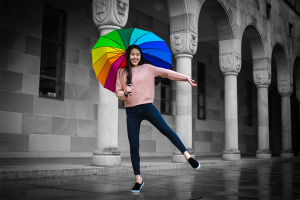The Mola of the Kuna Indians is a vibrant textile art created by the Kuna people from Panama and Colombia. The word “mola” comes from the Kuna language (Dule Gaya), meaning “clothing.”
When the Spaniards and missionaries arrived in America during the fifteenth century, they brought new materials and changes in customs, including the introduction of fabric. Initially, the Kuna painted their skin with intricate drawings (tattoos). These designs were later transferred to fabrics, evolving into the beautiful handicrafts we recognize today.
Origins and Kuna Mythology
According to Kuna beliefs, passed down through generations in songs, three deities descended to Earth. Among them were twins named Olonitalipipileler and Kabayai, and a third deity called Ilamagun.
When Kabayai reached puberty, she changed her name to Magiryai. She became responsible for teaching women essential skills such as making hammocks, preparing threads and fabrics, sewing, childcare, pottery, and food preparation. This knowledge became the foundation of Kuna textile traditions.
Types of Mola Designs
The Mola of the Kuna Indians can be divided into three main categories:
- Abstract Forms:
These designs are inspired by dreams or the imagination of the artist. They represent the pure thought of the Kuna people. - Geometric Shapes:
These patterns often mimic the geometric structures of plants, such as leaves or stems. Aloe, a crucial medicinal plant in Kuna culture, is a common inspiration. - Living Forms:
These designs depict observations of living beings, including marine, terrestrial, and aerial fauna, as well as the flora found in the mountains of Panama and Colombia.

How to Create a Mola
Although I’m not an expert, I have observed my mother create hundreds of molas throughout my life. Here is a simplified process:
- Sketch the design on paper.
- Select several pieces of fabric in different colors, all the same size, and sew them together with long, loose stitches along the edges.
- Transfer the design from the paper onto the fabric to create patterns and guides for cutting and stitching.
- Make precise cuts to expose the layers of color below. Add additional fabric pieces for extra vibrancy if needed.
- Apply decorative stitches such as backstitch, cross stitch, or individual cross stitch.
The Modern Evolution of Mola Art
Today, the Mola of the Kuna Indians has transcended its traditional uses. It now appears in products such as bags, pillows, swimsuits, boots, and hairbands. Colombian designer Maria Cecilia Benedetti has successfully incorporated mola designs into her brand, Pitahaya Swimsuits, bringing this art to a broader audience.

Where to Buy Molas in Panama City
If you’re interested in purchasing authentic molas in Panama City, here are some recommended locations:
- The handicraft market at Plaza de 5 de Mayo
- Casco Viejo
- The artisan market at Panama Viejo
These markets offer a variety of molas and other unique souvenirs.
Conclusion
The Mola of the Kuna Indians is more than just art; it is a reflection of their history, culture, and creativity. I hope this article serves as a useful guide for students and tourists eager to learn about Kuna culture.









